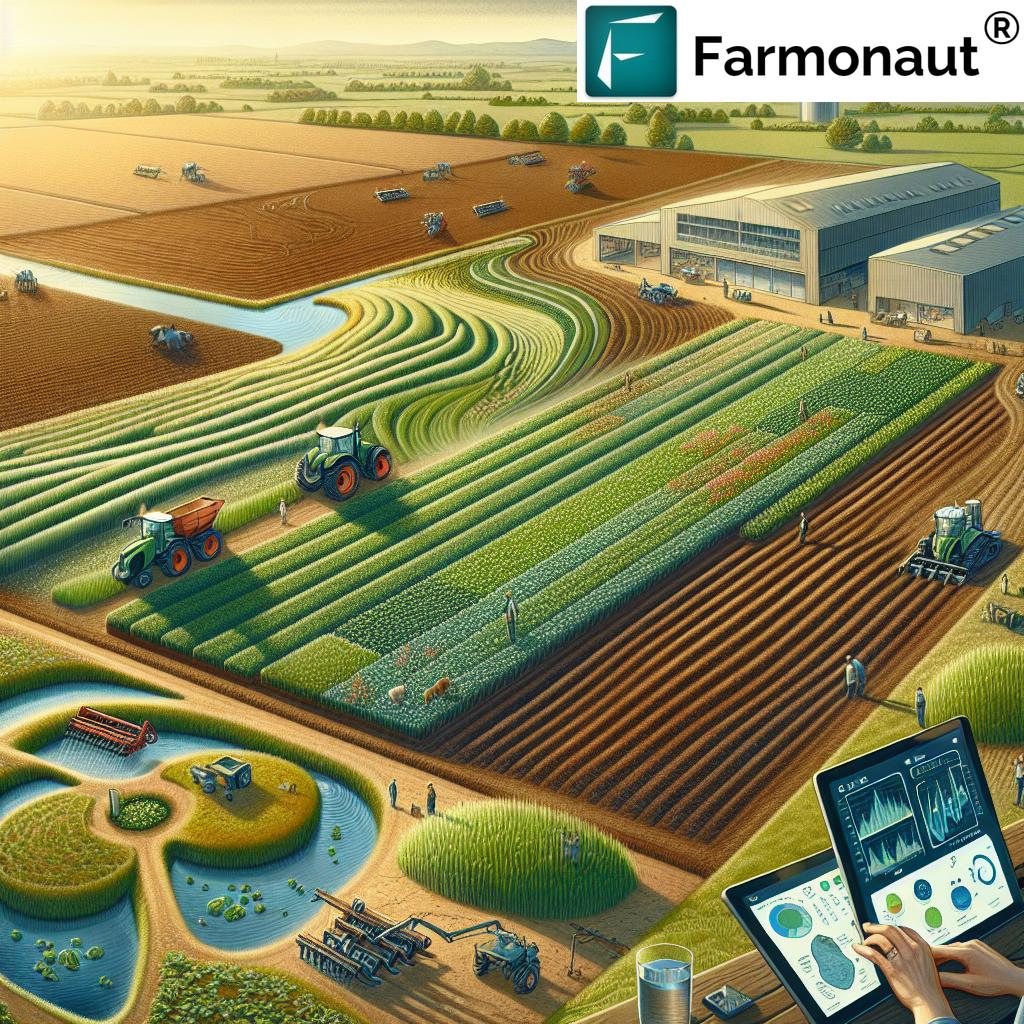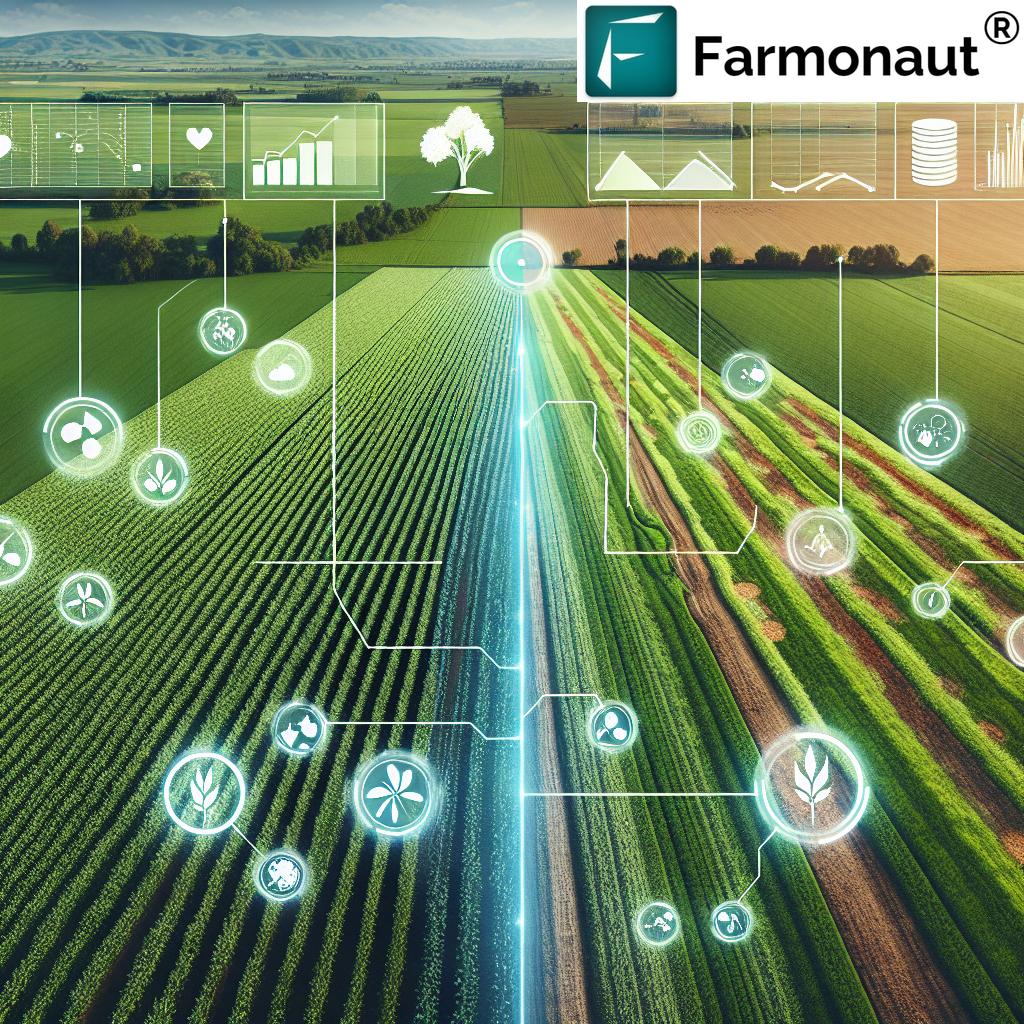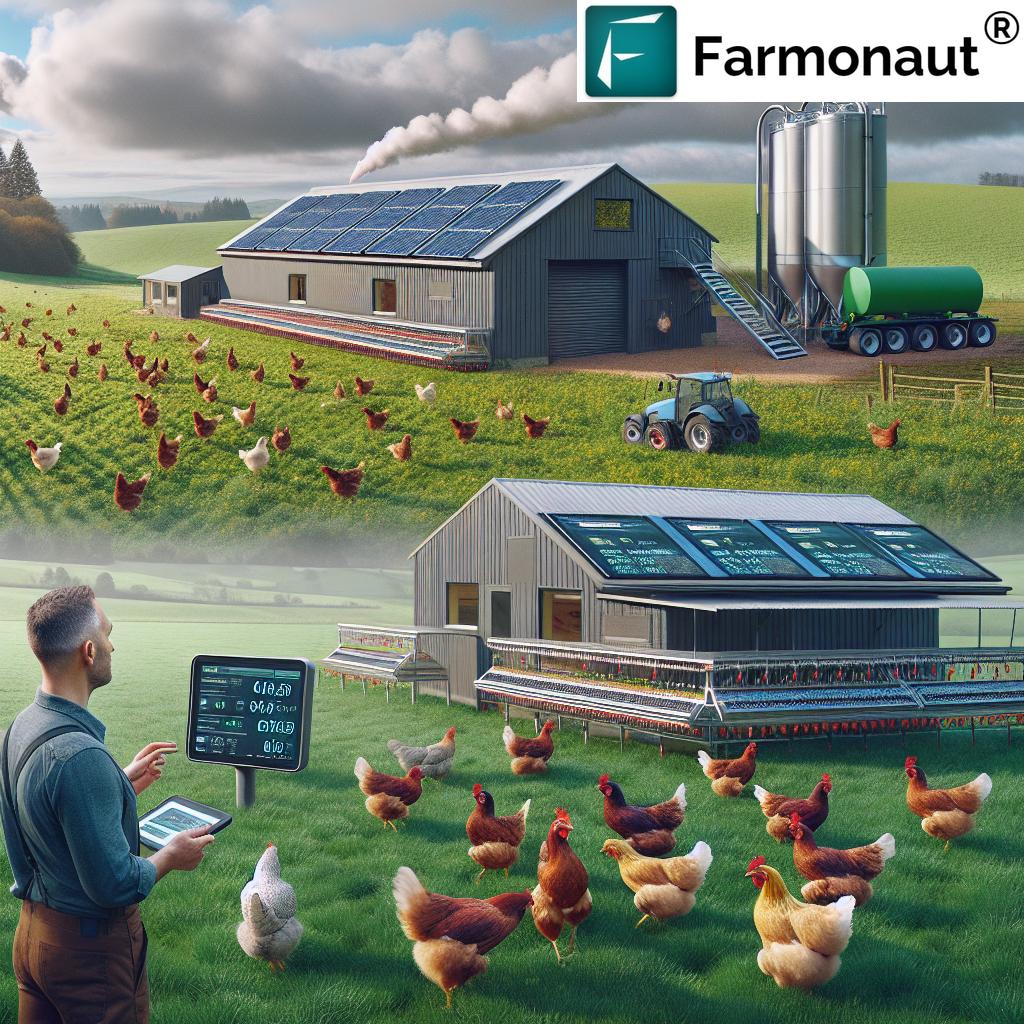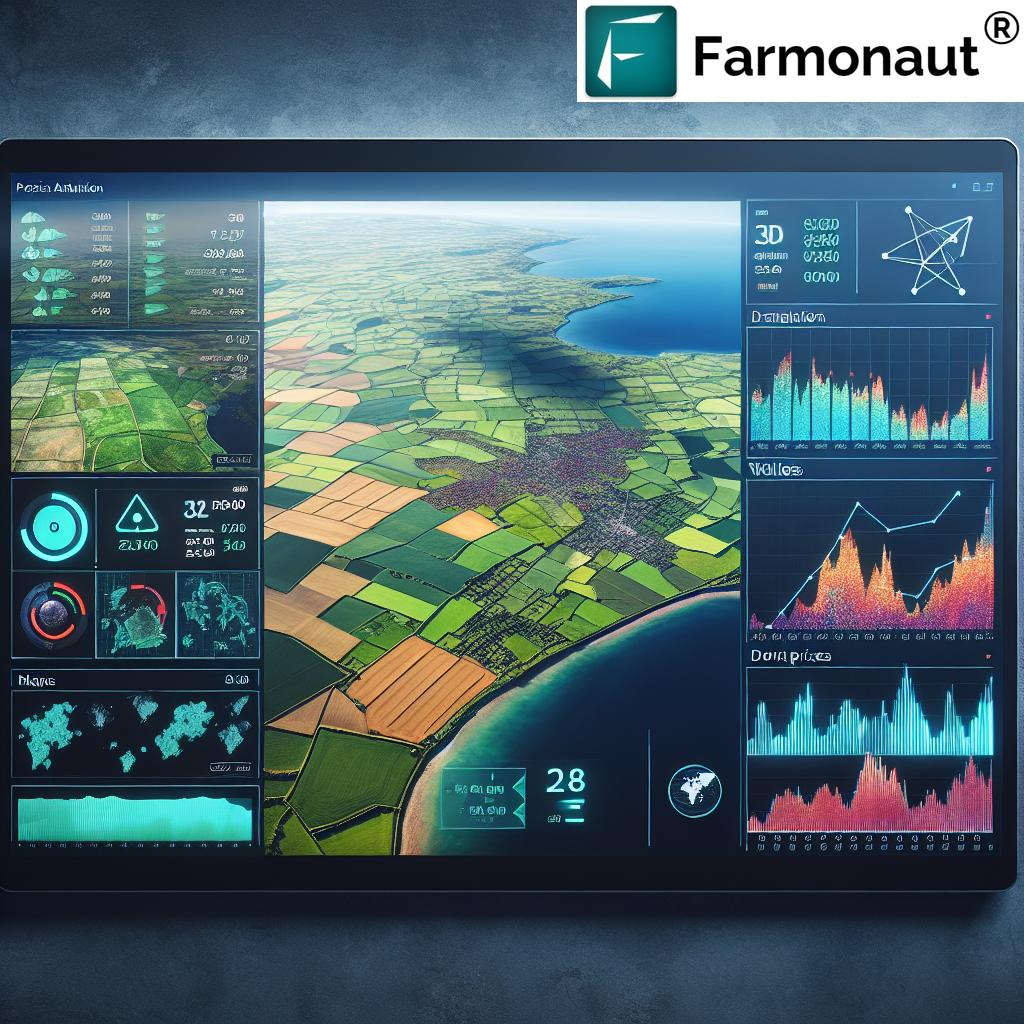Revolutionizing Wiltshire Farming: How Innovative Cultivation and Regenerative Practices Boost Soil Health and Crop Yields
“Wiltshire farmers implementing daily mob-grazing systems have reduced veterinary needs by up to 80% while improving pasture health.”
In the heart of Wiltshire, a quiet revolution is taking place in the world of agriculture. We’re witnessing a remarkable transition from traditional farming methods to innovative cultivation techniques and regenerative agriculture practices. This shift is not just changing the landscape of Wiltshire’s arable land; it’s transforming the very essence of how we approach farming, soil health, and crop yields.
As we delve into this fascinating journey, we’ll explore how farmers in Wiltshire are embracing change, adopting new technologies, and reimagining age-old practices to create a more sustainable and productive agricultural future. From the reintroduction of strategic tillage to the implementation of cover crop strategies and precision agriculture technology, we’ll uncover the multifaceted approach that’s reshaping farming in this picturesque English county.

The Shift from No-Till to Strategic Cultivation
For years, no-till farming has been hailed as a cornerstone of sustainable agriculture. However, Wiltshire farmers are discovering that a more nuanced approach might be necessary. The transition from strict no-till practices to strategic cultivation is a key aspect of this agricultural revolution.
- Reducing Glyphosate Dependence: One of the primary motivations behind this shift is the desire to reduce reliance on glyphosate, a widely used herbicide. By reintroducing some level of tillage, farmers can manage weeds more effectively without heavy chemical use.
- Improving Spring Crop Performance: Strategic cultivation has shown particular benefits for spring crops, especially barley following winter wheat. This targeted approach to soil management is helping to boost yields and crop health.
- Balancing Soil Health: While no-till farming has its advantages, strategic cultivation allows farmers to address specific soil issues, such as compaction, while still maintaining many of the benefits of minimal soil disturbance.
This shift represents a more balanced approach to arable farming, one that recognizes the need for flexibility and adaptation in agricultural practices.
Embracing Cover Crop Strategies
Cover crops are emerging as a crucial element in Wiltshire’s regenerative agriculture toolkit. These crops, planted during off-seasons or alongside main crops, offer multiple benefits to both the soil and the overall farm ecosystem.
- Soil Health Enhancement: Cover crops like phacelia and clover are being used to improve soil structure, increase organic matter content, and enhance nutrient cycling.
- Erosion Control: By maintaining living roots in the soil year-round, cover crops help prevent soil erosion, a significant concern in arable farming.
- Biodiversity Boost: These crops provide habitat and food sources for beneficial insects and wildlife, contributing to increased biodiversity on farms.
- Nitrogen Fixation: Leguminous cover crops, such as clover, fix atmospheric nitrogen into the soil, reducing the need for synthetic fertilizers.
The strategic use of cover crops is not just about soil health; it’s a holistic approach to farm management that aligns with the principles of regenerative agriculture.
Discover how Farmonaut’s satellite-based solutions can help optimize your cover crop strategies. Try our web app for real-time insights into your farm’s health.

Sustainable Crop Rotation: A Key to Long-Term Success
Crop rotation has long been a staple of good farming practice, but Wiltshire farmers are taking it to the next level. By implementing more diverse and thoughtful rotation systems, they’re seeing significant improvements in soil health and crop yields.
- Diverse Crop Selection: Rotations now include a wider variety of crops, each chosen for its specific benefits to soil health and subsequent crops.
- Pest and Disease Management: Varied rotations help break pest and disease cycles, reducing the need for chemical interventions.
- Nutrient Management: Different crops have different nutrient needs and contributions, creating a more balanced soil nutrient profile over time.
- Soil Structure Improvement: The diverse root systems of various crops help improve soil structure and water retention capacity.
This approach to crop rotation is not just about what’s planted this season, but about creating a long-term plan for sustainable and productive farmland.
Precision Agriculture: Technology Meets Tradition
The integration of precision agriculture technology is playing a crucial role in Wiltshire’s farming revolution. These advanced tools are helping farmers make more informed decisions and optimize their resources.
- Satellite Imagery: Farmers are using satellite data to monitor crop health, soil moisture levels, and other critical metrics. This technology allows for targeted interventions and resource allocation.
- GPS-Guided Machinery: Precision planting and harvesting equipment guided by GPS reduces overlap and increases efficiency in field operations.
- Soil Mapping: Detailed soil maps help farmers understand the variability within their fields, allowing for tailored management strategies.
- Variable Rate Technology: This allows for precise application of inputs like fertilizers and seeds based on specific field conditions.
The adoption of these technologies is helping Wiltshire farmers bridge the gap between traditional knowledge and modern innovation.
Farmonaut’s API offers advanced satellite and weather data integration for precision agriculture. Explore our API to enhance your farming operations.
“Strategic cultivation and cover crop strategies have increased spring barley yields by 25% following winter wheat in Wiltshire farms.”
Livestock Integration: The Power of Mob-Grazing
In Wiltshire, the integration of livestock into arable systems is gaining traction, with a particular focus on daily mob-grazing systems. This approach is revolutionizing both pasture management and animal health.
- Pasture Health: Daily rotation of livestock helps prevent overgrazing and allows for optimal grass recovery.
- Soil Fertility: The concentrated presence of animals in small areas for short periods leads to even distribution of manure, naturally fertilizing the soil.
- Reduced Veterinary Needs: The constant movement to fresh pasture has significantly reduced health issues in livestock, cutting veterinary costs.
- Biodiversity Enhancement: This grazing system promotes diverse plant growth in pastures, supporting a wider range of wildlife.
The implementation of mob-grazing is a prime example of how regenerative practices can benefit both livestock and arable farming systems.

Soil Carbon Sequestration: A Win-Win for Farmers and the Environment
One of the most exciting developments in Wiltshire farming is the focus on soil carbon sequestration. This practice not only improves soil health but also offers potential economic benefits through carbon credits.
- Increased Organic Matter: Practices like cover cropping and reduced tillage help increase soil organic matter, sequestering carbon from the atmosphere.
- Improved Soil Structure: Higher carbon content leads to better soil structure, water retention, and nutrient availability.
- Carbon Credit Potential: Farmers are exploring opportunities to monetize their carbon sequestration efforts through carbon credit markets.
- Climate Change Mitigation: By sequestering carbon, Wiltshire farms are contributing to global efforts to combat climate change.
This focus on carbon sequestration represents a significant shift towards viewing farms not just as food production systems, but as active participants in environmental stewardship.
The Role of Technology in Modern Wiltshire Farming
As Wiltshire farmers embrace regenerative practices, they’re also leveraging cutting-edge technology to enhance their operations. Tools like Farmonaut’s satellite-based farm management solutions are playing a crucial role in this transformation.
- Real-Time Crop Monitoring: Satellite imagery provides up-to-date information on crop health, allowing for timely interventions.
- AI-Driven Insights: Advanced algorithms analyze farm data to provide personalized recommendations for crop management.
- Resource Optimization: Technology helps farmers make data-driven decisions about water usage, fertilizer application, and other critical inputs.
- Weather Forecasting: Accurate, localized weather predictions enable better planning and risk management.
These technological advancements are empowering Wiltshire farmers to make more informed decisions, leading to improved yields and more sustainable practices.
Experience the power of satellite-based farm management with Farmonaut’s mobile apps. Download now for Android or iOS.


Comparative Analysis: Traditional vs. Regenerative Farming in Wiltshire
| Agricultural Practice | Traditional Method | Regenerative Method | Benefits |
|---|---|---|---|
| Tillage | Intensive tillage | Strategic cultivation with reduced tillage | Reduced glyphosate use, improved spring crop performance |
| Cover Cropping | Limited or no use of cover crops | Diverse cover crops (e.g., phacelia, clover) | Enhanced soil health, increased biodiversity, improved nutrient cycling |
| Crop Rotation | Simple rotations with few crops | Complex rotations with diverse crops | Better pest management, improved soil structure, balanced nutrient profile |
| Livestock Management | Continuous grazing | Daily mob-grazing system | Improved pasture health, reduced veterinary needs, enhanced soil fertility |
| Soil Health Management | Focus on chemical inputs | Emphasis on building organic matter and soil biology | Increased carbon sequestration, improved water retention, enhanced nutrient availability |
Challenges and Future Outlook
While the transition to regenerative practices in Wiltshire has shown promising results, it’s not without its challenges. Farmers face several hurdles as they navigate this new agricultural landscape:
- Initial Costs: Implementing new practices and technologies often requires significant upfront investment.
- Learning Curve: Adopting regenerative methods requires new knowledge and skills, necessitating ongoing education and support.
- Market Adaptation: There’s a need for markets to recognize and value products grown using regenerative practices.
- Policy Support: Aligning agricultural policies with regenerative principles is crucial for long-term success.
Despite these challenges, the future of farming in Wiltshire looks bright. The combination of traditional wisdom with modern innovation is creating a more resilient and sustainable agricultural system. As more farmers embrace these practices and technologies, we can expect to see continued improvements in soil health, crop yields, and environmental stewardship.
The journey of Wiltshire’s farmers serves as an inspiring example of how agriculture can evolve to meet the challenges of the 21st century while honoring its deep-rooted traditions.
Conclusion: A New Era for Wiltshire Agriculture
The agricultural revolution unfolding in Wiltshire represents a significant shift in how we approach farming. By blending innovative cultivation techniques with regenerative practices, farmers are not just improving their yields; they’re nurturing the very foundation of agriculture – the soil.
From the strategic reintroduction of tillage to the implementation of cover crops and mob-grazing systems, every aspect of this new approach is designed to work in harmony with nature. The integration of cutting-edge technology, exemplified by platforms like Farmonaut, is enabling farmers to make more informed decisions and optimize their resources like never before.
As we look to the future, it’s clear that the lessons learned in Wiltshire will have far-reaching implications for agriculture worldwide. This holistic approach to farming not only promises better yields and healthier soils but also offers a pathway to more sustainable and resilient food systems.
The revolution in Wiltshire farming is more than just a local success story; it’s a blueprint for the future of agriculture – one that balances productivity with sustainability, and innovation with respect for the land.
FAQ Section
Q: What are the main benefits of regenerative agriculture practices in Wiltshire?
A: The main benefits include improved soil health, increased biodiversity, better water retention, reduced reliance on chemical inputs, and potential for carbon sequestration.
Q: How does strategic cultivation differ from traditional tillage?
A: Strategic cultivation involves minimal and targeted soil disturbance, aimed at addressing specific issues like compaction or weed management, while maintaining many of the benefits of no-till farming.
Q: What role do cover crops play in Wiltshire’s regenerative farming practices?
A: Cover crops improve soil structure, increase organic matter, prevent erosion, fix nitrogen, and enhance biodiversity on farms.
Q: How is technology contributing to the farming revolution in Wiltshire?
A: Technologies like satellite imagery, GPS-guided machinery, and AI-driven insights are helping farmers make more informed decisions, optimize resource use, and monitor crop health more effectively.
Q: What is mob-grazing, and how does it benefit both livestock and soil health?
A: Mob-grazing involves rotating livestock frequently through small paddocks, improving pasture health, soil fertility, and animal welfare while reducing veterinary needs.
Explore Farmonaut’s comprehensive solutions for modern agriculture. Visit our API Developer Docs to learn how you can integrate our technology into your farming operations.

















